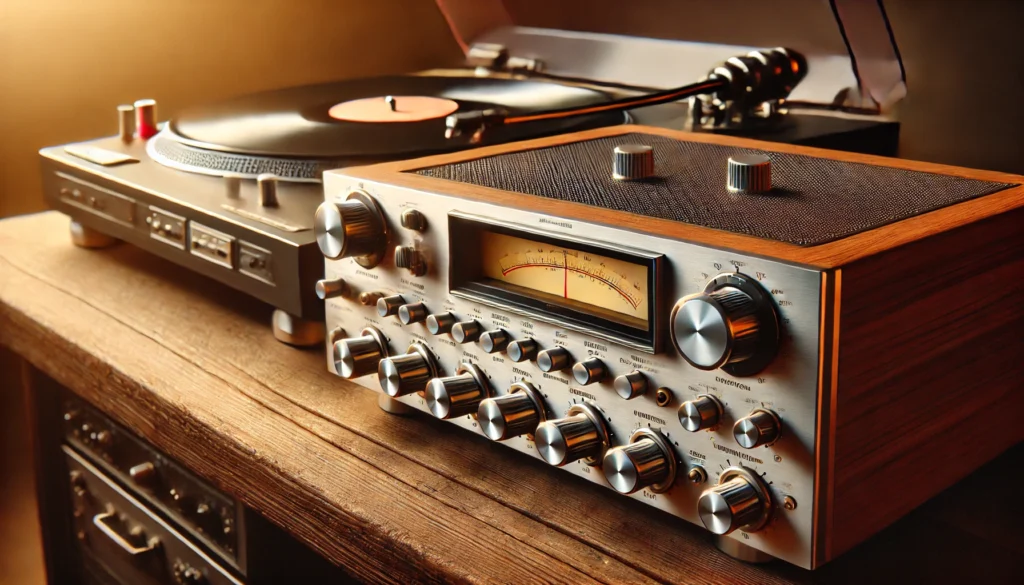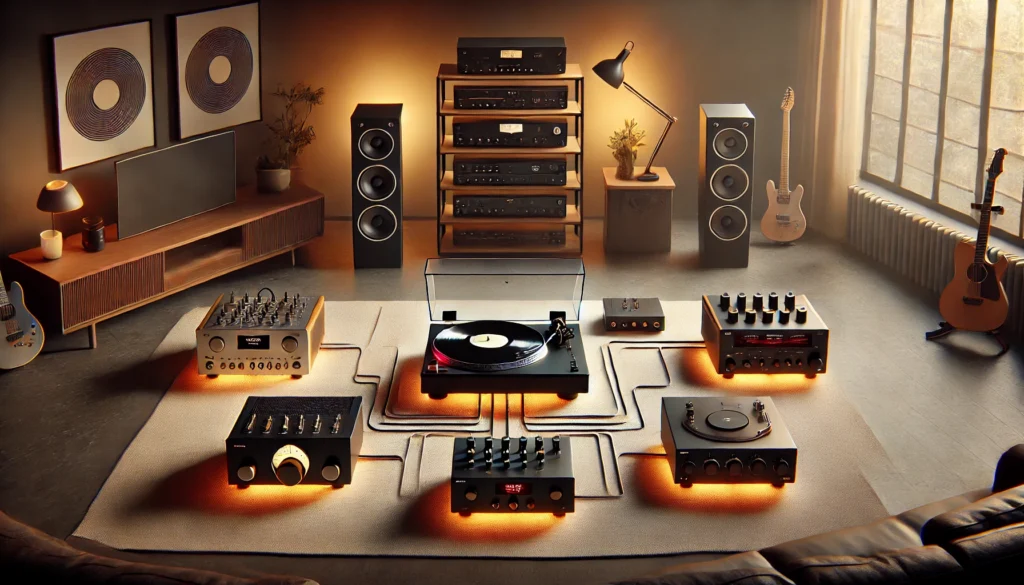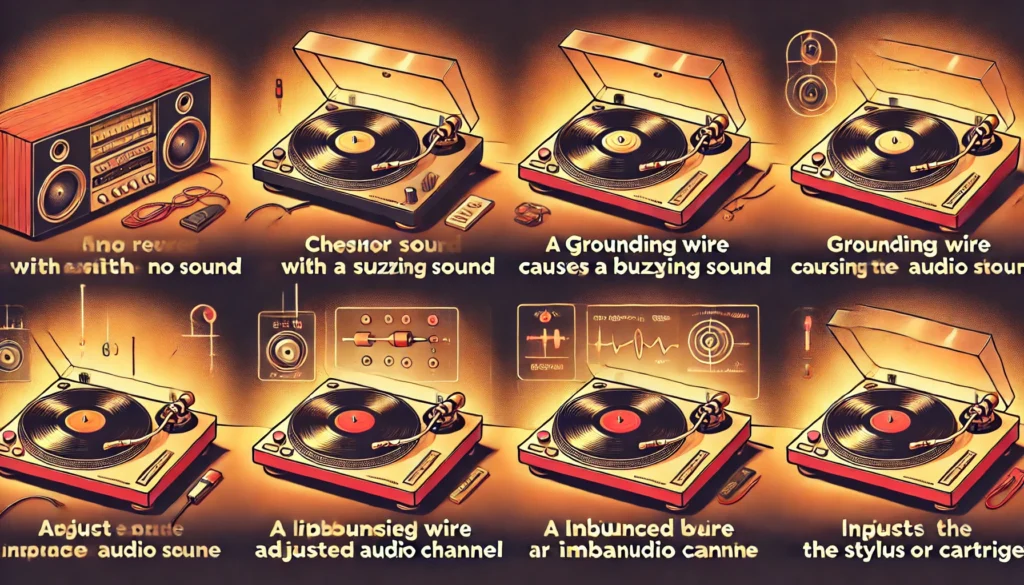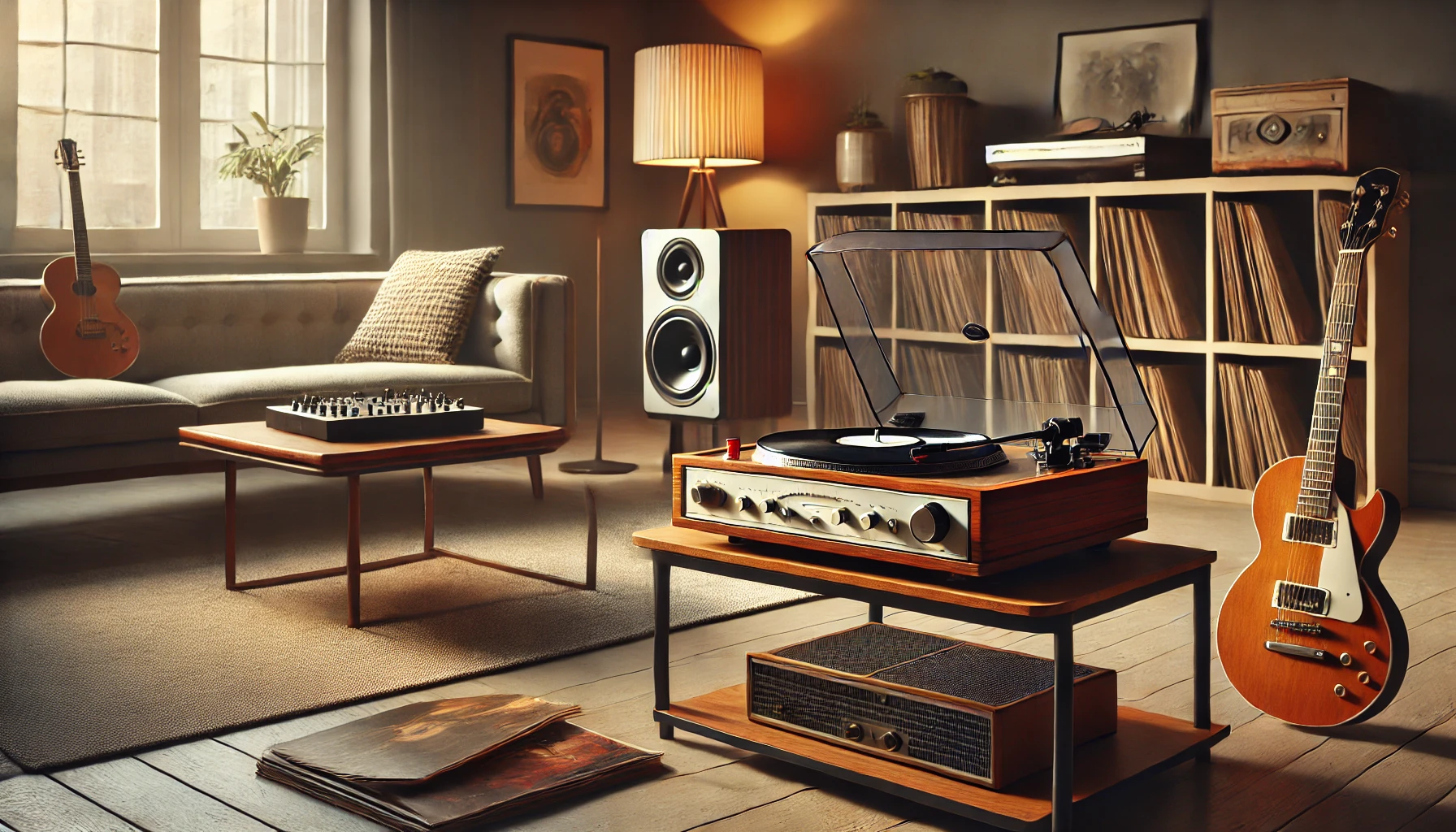The resurgence of vinyl has brought with it a wave of nostalgia and a renewed appreciation for analog sound. But for many newcomers to the world of turntables, the complexity of audio setups can be overwhelming.
One question that often comes up is whether a receiver is necessary for a turntable setup. Let’s dive into this topic and clear up any confusion!
Do I Need a Receiver for My Turntable?

In most cases, you do need a receiver for your turntable, but there are exceptions. If you have a turntable with a built-in preamp, you can connect it directly to powered speakers without a receiver.
However, for traditional turntables without a built-in preamp, a receiver (or an alternative like a separate phono preamp) is necessary to boost and equalize the signal before sending it to speakers. The choice ultimately depends on your specific turntable model and desired audio setup.
Stick around as we explore this topic in more depth, covering everything you need to know about turntables, receivers, and the alternatives available!
Now, let’s break down the details to help you understand exactly what you need for your vinyl setup.
What is a Receiver and Its Role in a Turntable Setup?

Alright, let’s start with the basics. A receiver is like the command center of your audio system.
It’s that big box with all the knobs and buttons that you might’ve seen in your parents’ or grandparents’ living room. Trust me, I’ve spent countless hours fiddling with my dad’s old receiver, trying to get the perfect sound!
A receiver typically performs several main functions. First, it amplifies the audio signal from your turntable (or other sources) to power your speakers.
It also allows you to switch between different audio sources, like your turntable, CD player, or radio. Additionally, it provides tone controls for adjusting bass and treble, letting you fine-tune your sound.
But here’s the kicker – not all turntables need a receiver to work. It all depends on the type of turntable you have and the kind of setup you’re going for.
Let me tell you, I learned this the hard way when I bought my first turntable and couldn’t figure out why it wasn’t working with my computer speakers!
The primary reason many turntables need a receiver is because of something called RIAA equalization. When vinyl records are made, the bass frequencies are reduced, and the treble frequencies are boosted.
This is done to allow for longer playing times and to prevent the needle from jumping out of the groove. The receiver’s phono preamp applies the necessary equalization to restore the proper balance of frequencies.
Without this equalization, your music would sound thin and tinny.
Types of Turntables: Built-in Preamp vs. External Preamp

Now, this is where things get a bit technical, but stick with me – I promise it’ll make sense!
There are two main types of turntables. First, we have turntables with a built-in preamp.
These bad boys are like the Swiss Army knives of the turntable world. They have a preamp built right in, which means they can connect directly to powered speakers or a regular amplifier.
No receiver needed! When I discovered these, it felt like a revelation.
Suddenly, my vinyl setup became so much simpler.
The built-in preamp does all the necessary amplification and RIAA equalization internally. This means you can plug these turntables directly into any line-level input (like the AUX or CD input) on a stereo system or powered speakers.
It’s a great option for beginners or those who want a more streamlined setup.
However, there’s a trade-off. Built-in preamps are generally not as high-quality as separate components.
If you’re an audiophile looking for the absolute best sound quality, you might find the built-in preamp limiting.
On the other hand, we have turntables without a built-in preamp. These are the more traditional types.
They output a very weak signal that needs to be boosted and equalized before it can be amplified. This is where a receiver with a phono input comes in handy.
Or, you can use a separate phono preamp. I remember the first time I connected one of these to a regular amplifier without a phono preamp – all I got was a faint, tinny sound.
Not exactly the rich vinyl experience I was hoping for!
These turntables offer more flexibility and potentially higher sound quality. You can choose a high-quality external preamp that matches your preferences and budget.
As you upgrade your system over time, you can swap out components without needing to replace the entire turntable.
Some turntables even offer the best of both worlds – they have a built-in preamp that can be bypassed if you want to use an external one. Talk about flexibility!
Alternatives to Traditional Receivers

Okay, so what if you don’t want to shell out for a full-blown receiver? Don’t worry, I’ve got you covered.
There are a few alternatives that can get you spinning vinyl without breaking the bank.
First up, we have integrated amplifiers. These are like receivers without the radio tuner.
They’re great if you’re just focused on playing records and don’t need all the extra bells and whistles. An integrated amp combines a preamp and power amp in one unit.
Many modern integrated amps come with a phono stage built-in, making them perfect for turntable setups.
I remember when I upgraded from a receiver to an integrated amp – the improvement in sound quality was noticeable. The focused design often results in better performance for the price.
Another option is powered speakers. Some powered speakers have a phono input, which means you can connect your turntable directly to them.
It’s a compact solution that’s perfect for small spaces. I used this setup in my college dorm room, and let me tell you, it was a game-changer!
Powered speakers have built-in amplifiers, so you don’t need a separate amp. Some even have Bluetooth connectivity, allowing you to easily switch between vinyl and digital sources.
Just be aware that not all powered speakers have a phono input – make sure to check before you buy.
If you’re looking for more flexibility, consider using a phono preamp with active speakers. This setup allows you to use a small phono preamp to boost the turntable’s signal, then connect it to any powered speakers or audio system.
This approach allows you to mix and match components. You could start with a budget phono preamp and upgrade later without needing to replace your whole system.
Plus, it’s a great way to add turntable compatibility to an existing audio setup.
Lastly, we have all-in-one turntable systems. These systems include everything you need in one package – turntable, preamp, amplifier, and speakers.
They’re super convenient and great for beginners or those with limited space.
I got one of these for my mom, who wanted to listen to her old records but didn’t want to deal with a complicated setup. She loves it!
Just keep in mind that you’re trading some sound quality and upgrade potential for convenience.
Factors to Consider When Deciding on a Receiver

Alright, so you’re thinking about getting a receiver. Here are a few things to keep in mind.
First and foremost, consider your budget. Receivers can range from affordable to “holy cow, that costs more than my car!”
Figure out what you’re comfortable spending. Trust me, I’ve been tempted by those high-end models, but my wallet usually brings me back to reality!
Remember, you don’t always get what you pay for in audio. Sometimes, a mid-range receiver can sound just as good as a high-end one to most ears.
It’s all about finding the sweet spot between price and performance.
Next, think about space. Receivers can be bulky.
Make sure you have room for it in your setup. I once bought a receiver that was too big for my shelf, and let’s just say it didn’t end well for my toes!
Consider the ventilation needs too. Receivers can generate a lot of heat, so they need space to breathe.
If you’re tight on space, you might want to consider one of the alternative options we discussed earlier.
Sound quality is another crucial factor. If you’re an audiophile, you might want to invest in a higher-quality receiver.
But if you’re just starting out, a basic model will probably do just fine.
Pay attention to specifications like Total Harmonic Distortion (THD) and Signal-to-Noise Ratio (SNR). Lower THD and higher SNR generally mean better sound quality.
But don’t get too hung up on specs – trust your ears!
It’s also worth thinking about future expansion. Consider whether you might want to add more components to your system down the line.
A receiver with multiple inputs can give you more flexibility in the future.
For example, you might want to add a CD player, a streaming device, or even a second turntable later. Having extra inputs will save you the hassle of constantly unplugging and re-plugging devices.
Don’t forget about features. Modern receivers come with a variety of bells and whistles.
Do you need Bluetooth connectivity? How about multi-room audio?
4K video passthrough for a home theater setup?
I once bought a receiver with a ton of features I thought I’d use, only to realize I only ever used about 10% of them. Be honest with yourself about what you’ll actually use to avoid paying for features you don’t need.
Last but not least, consider compatibility. Make sure the receiver you choose is compatible with your other equipment.
Check the power output against your speakers’ requirements, and ensure it has the right types of inputs for all your devices.
I learned this lesson the hard way when I realized my new speakers were 4 ohms and my receiver could only handle 8 ohm speakers safely. Always double-check these details!
How to Connect a Turntable to a Receiver

Okay, let’s get down to the nitty-gritty of connecting your turntable to a receiver. First, you’ll want to look for the “Phono” input on your receiver.
It’s usually labeled pretty clearly.
Next, you’ll connect the RCA cables from your turntable to this input. The red plug goes to the red input, and the white (or black) plug goes to the white input.
If your turntable has a grounding wire (it looks like a thin, exposed wire), connect it to the grounding post on the receiver. This helps reduce humming.
Finally, select the “Phono” input on your receiver, and you’re good to go! I remember the first time I did this – I was so nervous about messing it up.
But once I got it right, and that first record started playing… man, it was magic!
If your turntable has a built-in preamp, or if you’re using a separate phono preamp, you’ll connect to a standard line-level input instead (like CD or AUX). In this case, make sure any built-in preamp is switched on, or that your external preamp is connected between the turntable and the receiver.
A quick tip: Always make sure your receiver is turned off when connecting or disconnecting components. This prevents any loud pops or potential damage to your speakers.
Troubleshooting Common Issues

Even with the best setup, things can sometimes go wrong. Let’s talk about a few common issues and how to fix them.
First up is the dreaded “no sound” problem. If you’re not getting any audio, start by checking all your connections and make sure you’ve selected the right input on your receiver.
If you’re using a turntable with a built-in preamp, make sure it’s switched on. Also, check if your receiver’s mute function is activated.
Buzzing or humming is another common issue. This is often a grounding problem.
Make sure your grounding wire is connected properly. If the problem persists, try connecting the grounding wire to different metal parts of your receiver.
Sometimes, electrical interference from other devices can cause humming – try moving your turntable away from other electronics.
Channel imbalance, where one speaker is louder than the other, can be frustrating. Start by checking your connections and the balance control on your receiver.
It could also be an issue with your turntable’s cartridge alignment or the tonearm’s anti-skate setting.
If you’re experiencing skipping or distortion, this could be due to a worn needle, improper turntable setup, or even a warped record. Check your stylus for wear and make sure your turntable is on a level surface.
If it’s just one record causing issues, it might be time to clean it or replace it if it’s too damaged.
Lastly, speed issues can make your records sound too fast or too slow. If you’re experiencing this, your turntable’s speed might need adjusting.
Many turntables have fine speed adjustments hidden under the platter.
I’ve dealt with all of these at one point or another. The buzzing issue drove me crazy for weeks until I realized I had forgotten to connect the grounding wire.
Don’t be like me – check the simple things first!
Remember, vinyl playback involves a lot of precise mechanical processes. Regular maintenance of your turntable, including proper cleaning and occasional cartridge alignment checks, can prevent a lot of these issues.
Conclusion
So, do you need a receiver for your turntable? As we’ve seen, it really depends on your specific setup and needs.
If you have a turntable with a built-in preamp, you might be able to skip the receiver altogether. But if you’re working with a traditional turntable, a receiver (or one of the alternatives we discussed) can be a crucial part of your vinyl listening experience.
Remember, there’s no one-size-fits-all solution. The best setup is the one that works for you, your space, and your budget.
Don’t be afraid to experiment and ask for advice from other vinyl enthusiasts. And most importantly, enjoy the music!
Setting up a turntable system can seem daunting at first, but it’s also incredibly rewarding. There’s something special about the ritual of putting on a record, dropping the needle, and hearing those first crackles before the music starts.
It’s a physical, tangible connection to the music that you just don’t get with digital formats.
As you dive deeper into the world of vinyl, you’ll discover that it’s not just about the music – it’s about the experience. The large album artwork, the liner notes, the weight of the record in your hands – it all adds to the enjoyment.
And let’s not forget the thrill of crate-digging in record stores, hunting for that rare pressing or discovering a new favorite album.
Whether you’re rescuing your parents’ old records from the attic or building a collection from scratch, remember that the most important thing is to have fun with it. Don’t get too caught up in having the “perfect” setup – even a basic system can provide hours of listening pleasure.
Hey, why not share your own turntable setup in the comments? I’d love to hear about what’s working for you, or help troubleshoot if you’re having any issues.
After all, we vinyl lovers gotta stick together! And who knows?
Maybe your setup will inspire someone else to start their own vinyl journey. Happy listening, everyone!
